When he arrived in Australia in the mid-80’s, Eventing gold medallist, Tad Coffin was a revelation, his American style of instruction was very different to the laid back Aussie style: riders had to concentrate 110%, lessons were exhausting and oh so stimulating…
It is sometimes said that those who cannot do – educate. There can be few individuals in the horse world who do better to refute the saying than American horseman and teacher Tad Coffin. Here is one teacher who has comprehensively proven his abilities at the highest level of competition. Nine years ago, when he was only twenty-one, Tad won the individual Gold Eventing Medal at the Montreal Olympics… nowadays Tad is attacking the task of passing his knowledge on to his students with the same enthusiasm he fronted those fearsome cross country fences. Driven now not by visions of individual success and glory but by a vision of a learning centre to take the place of the great Cavalry Schools of the past. The ideal of an all-round and thorough Equestrian Education.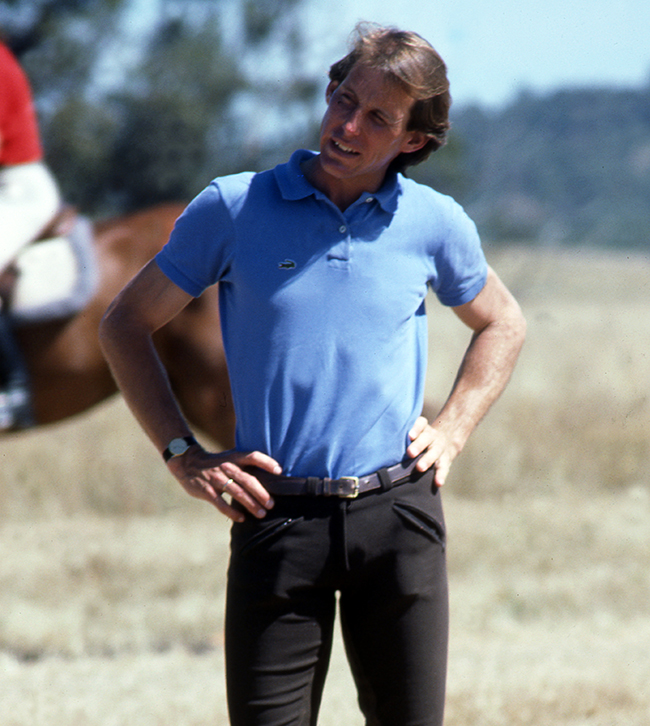
For the past five years, Tad Coffin as been coming to Australia. Making himself available to a group of eventing enthusiasts and offering them the closest thing to continuity of instruction that this country can provide.
The riders who have found time to attend the schools have found them an exhilarating experience… Tad has the uncanny ability to turn the most routine exercise into an exciting challenge; he also has the true teacher’s gift of the arresting turn of phrase – that bright new expression that brings a complex idea to life. It is Tad who farewells you with a phrase that deserves inscribing in the brain of every rider – “The goal of any rider is to have the horse fall in love with your hands.”
Out of the arena the work was simple, deceptively simple… Here are all these eventers, some of them moderately famous eventers riding well performed horses and they are going over little Pony Club lines of cavaletti. Surely this is kids stuff – where are all those cross country fences?
As always Tad has a lucid and elegant explanation.
“One of the things that all good trainers have come to realise is that if you need to jump a course of five foot fences, you don’t need to jump five foot fences every day, or four times a week, or even three times a week, in order to prepare for that. You can break down the elements that are required, and work on them piece-meal and in a smaller version. I think that the Americans have honed this kind of idea, with the help of Bert de Nementhy, better than anybody else.”
“The idea is that there are four basic components to jumping. One is the rhythm that the horse is going in. The rhythm is in tum a compilation of his frame, his balance, his engagement, his impulsion and his speed.”
“The next element is balance – this is the balance that a rider has, not only in the approach but also in the air over the fence.”
“Then we have the track or the geometry of the course, and the final element in jumping is timing.”
Tad has his students out and working over the set of cavaletti, snapping their minds to attention, rivetting their focus on this seemingly simple task… “We must get into the spirit of the cavaletti, we must relentlessly attack any weakness.”
The pupils will find themselves relentlessly pursuing all manner of gymnastic exercises over the next few days.
Read on and join them on their journey
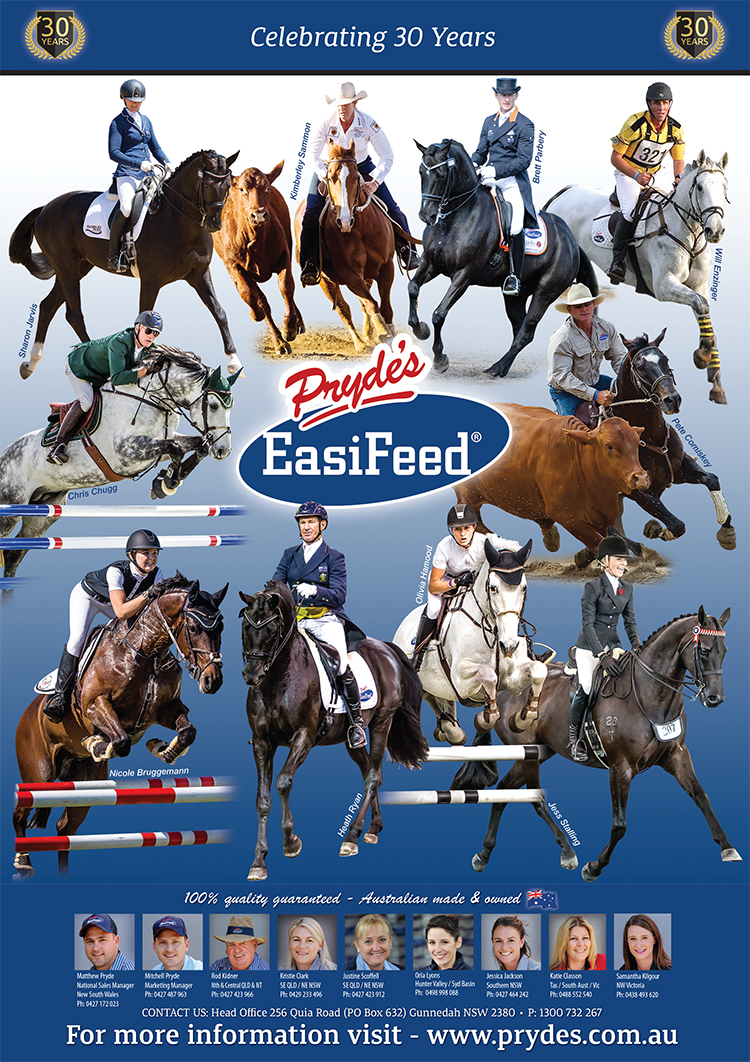
“The idea behind gymnastics is that you can work on all of those elements of good jumping on a very low level. At the most basic we can set up four cavalettis, and I can have very different strategies to the cavalettis. In regards to rhythm, the cavalettis require a very even pace. I can manipulate the horse’s rhythm at the last minute so that he’ll be right through the cavalettis, and then not worry about rhythm all the rest of the way around the ring, until we are back at the cavalettis. Or I can say – ‘I want to establish a rhythm that at any moment I could go through the cavaletti and the horse would go trot, trot, trot, trot -very even’. That is the strategy we adopt so that the cavalettis are useful.”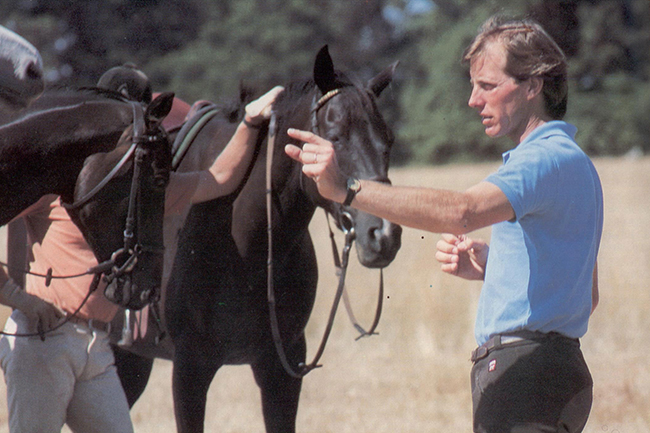
As is so often the case in the American school of horsemanship, behind every seemingly simple exercise is a lucid theory to explain how it works.
‘’We also say that the cavaletti is the first place where a rider has to design a turn – not only a turn in the approach but a turn afterwards. If a rider gets in the habit of making very good turns right to the centre of the cavaletti, going straight through, planning and making a very good tum on the other side, then he is working constantly on the idea of good geometry, good design. If he hones this skill on a daily basis using cavalettis and small gymnastics, then it is going to be much more natural for him to make a good approach to a fence.”
“The cavalettis require from the horse a little more animation – to get through them. The rider has to learn to follow that slightly more animated motion. The rider has to be balanced – he has to be able to go through the cavalettis with a contact, not falling back on the horse’s mouth and not falling ahead of the movement. If you go to the cavalettis and you are very particular about your balance, you teach riders a sense of following the motion, a sense of being with the horse; and you teach the horses a sense of balance, so that you can, again without jumping huge fences, make a point.”
“Any good rider will tell you that when they are trotting into cavalettis they see their distance. They see the distance because the horse gets into a rhythm, you know where his next foot fall is going to be in relationship to a fixed object – which is seeing a distance.”
“Cavalettis done on a regular basis improve a rider’s sense of timing, again without having to jump big fences. This is the idea behind cavalettis, it is also part of the idea behind gymnastics. In gymnastic jumping you can – once you understand the principles of gymnastics – design the exercise so it concentrates more on the development of rhythm, or more on the development of timing, or more on balance. You can vary and use them to any different emphasis.”
The cavaletti exercises were working on a multiplicity of levels. As straight exercise, as tests of roundness, or suppleness, of obedience but most of all, willingness. ‘’You must get away from belligerence with young horses, you must get the horse to the point where it loves your attitude. Try to make your aids invisible, try to make them inviting.”
“The point that I always try to make is that there is no magic in the gymnastic jumping installation. You can use them to tremendous benefit – to develop a better sense of timing, more confidence on the part of the rider, more confidence on the part of the horse, better form, better style, better discipline … or you can use them for no value at all!”
Read on
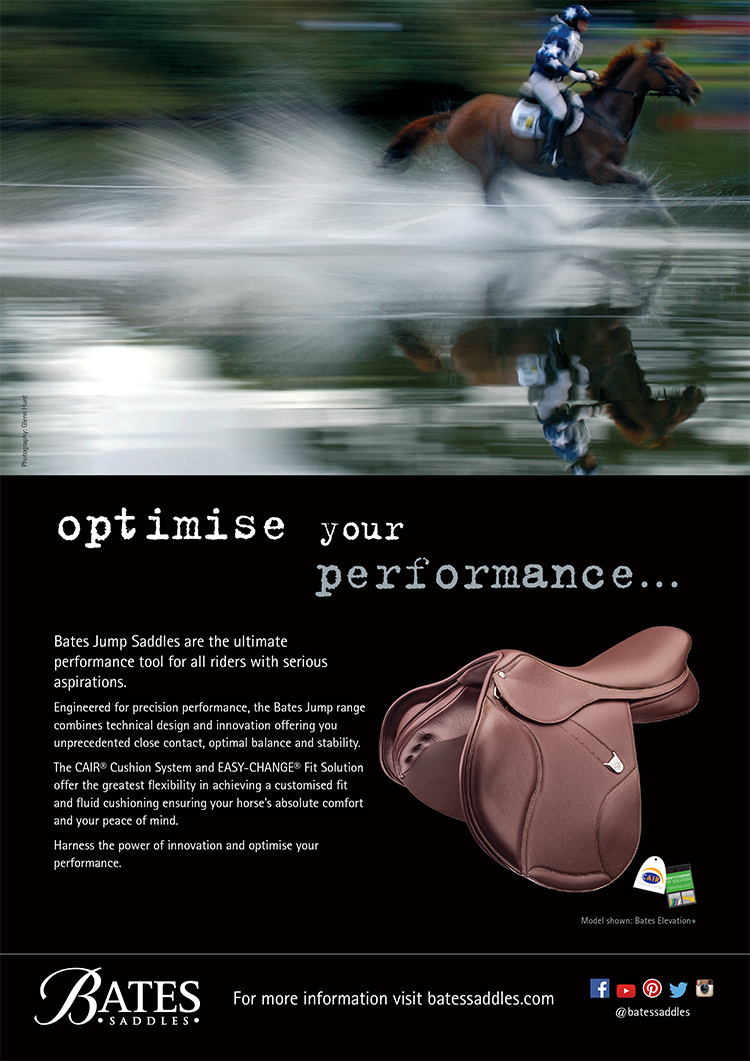
“It depends on your approach. I think the point of my schools in Australia this time was how to get the most out of gymnastic jumping.”
“Americans believe that riding is cumulative, meaning that everything is built on a very simple but necessarily strong foundation. If you spend a lot of time making that foundation very strong, then as you advance, you won’t have to drop back and correct faults that you didn’t take care of in the first place.”
“As you go on and you approach more difficult tasks you bring out and highlight resistances in the horse or faults on the part of the rider.”
“I think this is a little different from the Australian approach but I see a big change in the Australian approach in the few years that I have been coming here. I think the Australian approach is a little like – go as quickly as you can and advance as far as you can! For many riders this means they are very successful at a very early age, but it also means that there are quite a few riders who run into trouble at the top level because of a lack of a very good foundation. Their problems are going to catch up with them somewhere.”
“This has been something that I noticed in my schools. I have had some very good riders who advanced very quickly as young riders and then they got on a horse that didn’t match all of their strong points as riders, or got on horses that brought out the weaknesses in their riding and they were lost, none of that early success counted for much at all.”
“In order to negotiate the cavalettis, the horse has to first be able to have the quality of relaxation. If he doesn’t have the quality of relaxation he can’t negotiate the cavalettis. The cavalettis can be done with more and more sophistication. With a very novice horse or a novice rider, if they just maintain a correct rhythm – that is sufficient. But in a more sophisticated sense, the horse should be able to use his back more, the horse should be through the aids and up in his back.”
Tad is always warning against the easy options, and the easiest of all those options is riding the horse on the reins alone.
“Many, many times when we ride on the flat we have the tendency to ‘hand’ ride, and force the horses into a frame. You can get away with this riding on the flat, but you can’t get away with that riding through cavalettis, because if the horse’s back isn’t up, he can’t maintain the frame. So you might have what seems like a very nice outline in a horse going all the way around the ring, and when he comes to the cavalettis all of a sudden he comes above the bit, and the rider is making drastic measures to keep the horse’s head down. This is because the horse is not truly through the aids – so it is a very good test of flat work.”
“Reiner Klimke, for example, uses a lot of cavalettis to test the rhythm that he has on the flat – and many dressage riders use cavalettis to introduce passage. I use cavalettis in this sense – if I think the rhythm I have in the working trot is good, then I come to the cavalettis – if the horse comes through the cavalettis as if they weren’t there, and he makes no alteration in the contact, no alteration in the frame, no alteration in the rhythm, meets them right in stride and goes through them – then I know that my working gaits are correct.”
“It is more important to go through the cavalettis in the correct rhythm than the correct frame. What I think Americans have come to recognize is that the priority in jumping is not the frame of the horse but his rhythm. I would rather have a horse in a very relaxed rhythm, without the degree of flexion, than to have a horse with a high degree of flexion with uneven, irregular gait and a lot of tension in his back, because that doesn’t produce good jumping.”
“Frame with no rhythm and a horse with a hollow back is always going to produce a lot of hand riding, and horses that are not comfortable in their jumping.”
“The Americans believe that rhythm is an extremely important basis of jumping for any number of reasons. For example in the Hunter and Equitation Divisions that we have, it is stressed that riders should keep the same pace going all the way around the ring. This ability to maintain the rhythm demonstrates number one, a quality of relaxation in the horse. It demonstrates a quality of confidence in the horse. It demonstrates a very important basic principle in a rider’s education… that horses on their own don’t keep a very even rhythm. So by demonstrating the ability to keep an even rhythm you are showing that the rider has understood the nature of horse’s resistances and that is what riding is about – about anticipating and correcting resistances.”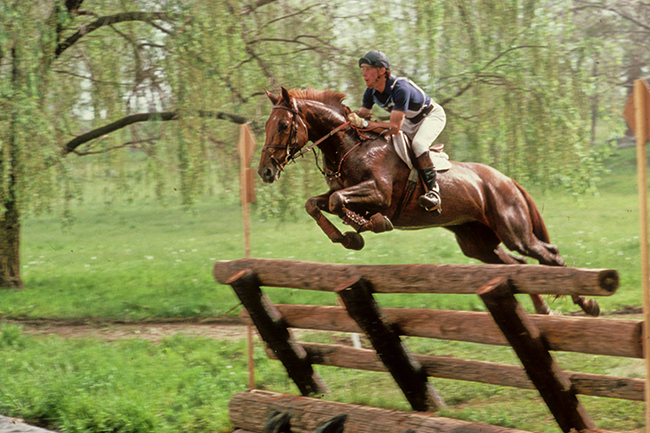
“Rhythm also leads on to another important part of the American approach – the development of the sense of timing. Timing comes in part when you can count on your horse’s rhythm and then you can count on his length of stride.”
“For the most part if you have an even rhythm you have an even length of stride. So if I work on a rider keeping this very even sense of rhythm, they are going to learn their horse’s length of stride and how that relates to a fixed object – and from that develop a much better sense of timing.”
“I think one of the interesting things about jumping and having a sense of timing is the phenomena that you can get with many riders, and I would say, even many good riders, who get on one horse and see distances without having to make any drastic moves lengthenings or shortenings of stride – and feel very comfortable with their sense of timing. That same rider can get on another horse and they can miss every distance. It’s not because their eye changed, it’s not something structural in the rider’s vision, it is just because the new horse’s rhythm is not as steady. The horse isn’t answering the aids going forward, he is not ready to wait and listen. If a horse is going forward and he is prepared to wait and listen then it should be very easy for him to produce a very nice even flowing canter. There is a tremendous tie in between rhythm and being able to develop a sense of timing.”
“I think one of the interesting things in riding is watching someone as good as Lucinda Green. She has a tremendous sense of rhythm. All combined training riders need that. Lucinda has an ability – as do many of the top riders – to develop in her horses and demonstrate in cross country, very even, regular pace. And that doesn’t mean that there are not times when you slow down or speed up, but overall her work shows such regularity of rhythm.”
“Unless he is standing still, then from the moment you get on him, the horse is in a rhythm – it can be regular or irregular – but everything in riding has rhythm to it. Rhythm is a very integral part of horsemanship.”
“One of the qualities of becoming a good rider and an educated rider, is becoming very familiar with horse’s resistances, because it is through their resistances that you teach them, or they teach you! There’s a real connection between the way a horse goes through a turn and the rhythm he has coming out of a turn.”
“If a horse is in a very nice rhythm, he is very even, he’s soft and supple and bending and relaxed, and he comes to a turn and leans in – falls in with his shoulder because he is not balanced – he is also going to lose his rhythm. Because rhythm is balance, rhythm is a demonstration of balance, so if this horse doesn’t get through the turn well, then the rhythm he has out of the turn has less quality – and this will in turn affect his performance through the cavaletti. “
“If the horse goes through the cavaletti and expects on the landing to lean in on his shoulder and cut the turn and become resistant, then he will start to become resistant each time, more and more, because this is a characteristic of resistances, and he will start to become more and more resistant through the cavaletti, then he will start to become resistant in the approach to the cavaletti!”
“If every time he comes through the cavaletti he makes, a very good turn which causes him to be more supple, this improves the rhythm for the cavalettis. If he goes through the cavalettis and expects to listen for a half halt and go straight and then bend, and then make a nice turn, this is also going to affect the quality of the cavalettis. Geometry and rhythm and balance and timing, we can call them separate qualities but they are all inter-related.”
Once again Tad, like so many true horsemen is fanatical about that elusive half halt…
“If you are saying that your half halts are not always working, that your half halts need to improve, that is the best statement you can make. It shows that you know what riding is about – a lifelong pursuit of good half halts.”
The group moves from the ring of cavalettis to a small gymnastic grid in the next arena…
“The exercises that follow the cavalettis are the gymnastic exercises. First simple exercises at the trot and graduating to more sophisticated exercises at the canter. The important thing at this stage is to understand the principles of gymnastic exercises and then design your own according to your horse and your needs. The principles are to continuously work on those four basic elements of jumping in progressively more difficult ways.”
“The way that the Americans use the gymnastics is not to be satisfied when they just get from one side of the grid to the other. The satisfaction comes when you do the gymnastics in such a way that the actual jumping effort is not difficult for the horse, or difficult for the rider. You are using it as a time to practise all the other elements that are involved in jumping – the style, the balance, the discipline of the landing. It is not a jumping contest.”
“With the riders here, I kept my fences low enough in the beginning so that they didn’t even have to think about the actual jumping effort and whether they were going to make it or not. The distances were very standard distances for gymnastics.”
“One of the reasons gymnastics were developed, especially by Bert de Nementhy, is the realisation that Thoroughbred horses have a response mechanism of taking longer strides and jumping from a longer distance and powering their way out of trouble.”
“That is their natural reaction, they were bred for racing, they were bred for long strides, for speed. In jumping they need to concentrate on collecting exercises, on being able to take a shorter stride, on being able to handle a closer take off point – so we structure the gymnastics with the idea of gradually increasing the Thoroughbred horse’s ability to collect through the gymnastic exercises. We can do this with a series of exercises, gradually shortening the distances … but the point is that they are a collecting exercise.”
As so often happens, once the horses saw the little line of jumps they wanted to run and rush and get to them. Once again the riders were enjoined to ‘relentlessly pursue the development of good habits’ – in this case a nice calm horse. For rider whose form over fences tended to make their horses quick, Tad offered the following advice…
“The best mistake you can make in this situation is to make too little a gesture and be left behind. The worst mistake you can make is too big, too quick a gesture because the Thoroughbred will use that gesture to quicken and lengthen his stride. Err on the side of doing too little. Feel as if you are deathly quiet on the back of the horse – feel as if the air currents are not disturbed by your body.”
“I think that one has to understand very well the influences on the horse while jumping. If I approach a fence at a trot in a nice quiet rhythm and I have a very good balance and attitude and the horse is relaxed, and three strides, or even one stride, away from my jump, I fling myself in the air and I make a very exaggerated motion with my body, my feet go back, my head goes down, my body is out of balance at that moment.”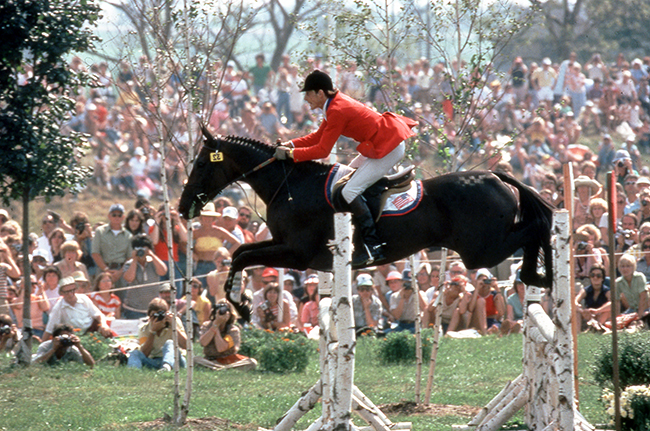
“Thoroughbred horses in particular are disturbed by that sudden distraction – and their response to any crisis is to run. You have a rider who has made this very big gesture in the air, now he lands, and he gets back the nice rhythm and collects the horse and everything is fine – he is coming to the same fence again… and in the approach the horse is not thinking about how nicely the rider is sitting at that moment, the horse is thinking of the wild gesture that the rider made last time – and how he should respond to it. He thinks that the rider wants him to go faster -and this is a very legitimate interpretation of the move. The next time he comes, three or four strides out, the horse starts to get a bit faster, and the rider again makes a wild move – if you do this often enough then the horse gets into a habit, and it is a habit that riders find it very difficult to deal with.”
“I think the point of the school was through the gymnastics – to teach the riders a better sense of balance. Then we worked on how the rider’s balance in the air influences the horse’s rhythm by influencing the psychology of the jump. If the rider comes into the fence and makes a very small gesture and doesn’t do anything to disturb the horse in the air, and the horse has learned to be relaxed and have a good rhythm, then there is no reason for the horse to be rushing.”
Once Tad was happy with the rider’s approach to the obstacles, the next phase to work through was the rider influence on the horse through the air.
“The feeling coming into the cavaletti is very tall, waiting, with calf support – now try to explore being in the air and above your feet and doing nothing. But keep the horse happy, use your voice have a constant conversation with the horse.”
‘’You have to look at the optimum performance of the rider in the air. We believe that the optimum performance of the rider in the air is to be in absolutely perfect balance with the horse, and in addition to be in a balance where we can aid the horse if necessary.”
“We are not thinking that the ultimate is lack of interference in the air. The best example of lack of interference is Kevin Bacon, because there is no relationship between Kevin Bacon and his horse whatsoever while they are in the air. He is completely away from the saddle, he is completely away from the horse’s mouth. This is non-interference at its very best – but I think Kevin Bacon has the ability to do this where very few people can. If I were to promote the priniciple of non-interference with most riders then the result would be an unmitigated disaster.”
“We strive for a perfection of the forward seat balance in the air. A balance where there is perfect harmony between horse and rider, where the rider is not behind the motion, where he is not ahead of the motion, but he is also available to the horse to aid him if necessary. This means that it is a calf oriented balance and its also a balance in which we try to keep the contact with the horse’s mouth.”
“I would say that the tendency on the part of the Australian riders is to make too exaggerated a motion in the air, and to be either ahead of the balance, or ahead, then a moment later, behind. I think that the Americans are more harmonious with their horses in the air than practically any other riders in the world.”
“In our Australian schools we started by working on the forward seat. We started on the flat in forward seat. The correct mechanics of jumping involve the same leg position as the forward seat or a very good rising trot with just a little closing of the hip angle and a forward inclination.”
“Through practice in the gymnastics, we concentrated on the mechanics of jumping, the method of release, the rider’s weight distribution down through the knees and calves and heels, as opposed to a knee grip with a light heel. It was just through repetition and concentration and discipline; the mechanics of jumping require a disciplined body motion, just as in figure skating or any other sport, you have to work on mechanical body actions to improve functions.”
“The American approach says that the forward seat is a little more of an athletic stance on the back of the horse. It requires a degree of suppleness, strength, fitness, balance, and the – American approach goes on to say that if wait to get into forward seat until we are going at 400 metres a minute or more, there is a good chance that we will not be very familiar or very comfortable in this more athletic stance, we will feel that we are struggling for our balance, we might feel unfit, we might feel uncomfortable – or we’ll have to be able to go 400 metres a minute a lot to feel comfortable … and overwork the horse.”
“So American riders are in the habit of riding in forward seat balance at slow speeds. Forward seat is a balance, it is a balance that has the ability to change as the speed and the rhythm of the horse changes. The forward seat at the walk, trot and slow canter is a very upright attitude, where the rider is minimally out of the saddle, and with no more inclination of the body forward than in the rising trot.”
“It really can be defined as the moment of rising when we are out of the saddle -suspended. That would be a very good way to characterise the forward seat at slow speed. We worked in the clinic on this strategy of working in forward seat at slow speeds, so that Australians can learn the advantage of working in forward seat, while in slow speed, so that they are more comfortable when they go forward in galloping position and they are going across country.”
“In the forward seat you need to put yourself into a balance that is comfortable and effective. It is a calf oriented balance as opposed to a knee grip. In parts of the world forward seat is promoted as a knee and thigh grip balance. Knee grip and balance in my mind are contradictory terms.”
“Balance means being able to stay on the back of the horse without using any article of the tack or any grip to maintain your balance. We want to develop a calf oriented stance on the back of the horse – again with the idea that if the calves are close to the horse they are going to have a much better working relationship with the horse than if they are far away.”
“Riders need to learn the different qualities of their aids. They need to learn that all aids have a sense of timing, all aids have a sense of gradation, how much leg do you put on? There is a quality of leg that good riders use. Good riders don’t use a tremendous amount of strength in their calves. Riding is not a matter of strength, it’s not a matter of grip – otherwise we would all be doing bodybuilding and riding would only be for the young and the strong and the super athletic. You have to learn a quality or a texture of calf – and also a texture of the rein aids.”
“All riders need very loose joints, loose hips, loose shoulders, loose elbows, loose knees, loose ankles. When I say loose I don’t mean uncontrollably loose, but they need to have a very good range of motion, and an absense of unwanted tension. A lot of riders when they are not comfortable in forward seat – especially the Australian riders that I have worked with – tend to grip with their knees, and tend to have a little stiffness in their ankles.”
Throughout his schools, Tad kept returning to his ‘principle of exaggeration’ – pupils at any time were likely to be reminded to put the principle of exaggeration into action…
“The principle of exaggeration is just what it sounds like. The principle of exaggeration is a statement about criticism in riding. One can never, I believe, strive for a lack of criticism in riding – because I don’t think that there is such a thing as perfect riding. I don’t think anybody’s performance is beyond some sort of criticism. One of the important parts in riding is being able to recognize always your good points, but also to be recognizing your weaknesses and striving to make those better. I think that an important attitude in riding towards criticism, is number one to move the criticism around. If you are constantly getting the same criticism then you are not making much progress. Riders should look, in educational terms, to shift the criticism and to make it more sophisticated.”
“We can have for example a very unsophisticated criticism – the rider who goes around with the heels up and the toes down – that’s not a particularly sophisticated criticism. Working on nuances of the shoulder in, and degrees of bending in certain exercises, those criticisms are a little more sophisticated. The rider should strive to shift criticism and at the same time it should become more sophisticated.”
“I talk about the principle of exaggeration. If we have a difficulty most of us tend to feel that with a little bit of correction we are really solving the problem. Viewing it from the ground, you recognize that this is not so. If a rider has a problem riding with the reins too long, I would rather have them exaggerate their reins and have them too short for the course of that day’s instruction. I would rather have to tell that rider ‘Now you have gone a bit too far’ – rather than constantly – ‘Your reins are too long, your reins are too long, your… “
“The rider’s reins are six inches too long and they shorten them a quarter inch! Then I say ‘No shorten again’ – another quarter inch. That’s when I say ‘Think about the principle of exaggeration’. Then they shorten ten inches and I say ‘Fine, now let’s go back four inches’. It’s important to know that you can swing from one problem to the reverse of that problem.”
“It is very possible to have your reins too long and the very next minute have your reins too short – but if you are doing that in the course of a lesson where someone is helping you find the point in which there is a middle ground, that’s fine. But if you are riding six inches too long – does it make any difference that they are five inches too long? No – the effect is still the same. This is the principle of exaggeration, it is something that many good riders just do. They are very keen on taking any correction that you give them to the fullest.”
Certainly the students in Tad’s schools take his advice to its fullest. He is the sort of instructor that inspires that sort of trust and dedication. The sort of instructor who jumps on board the most difficult horse in the group and sets about trying to solve its myriad of resistances by provoking a few more – but this time on Tad’s terms, within his area of control.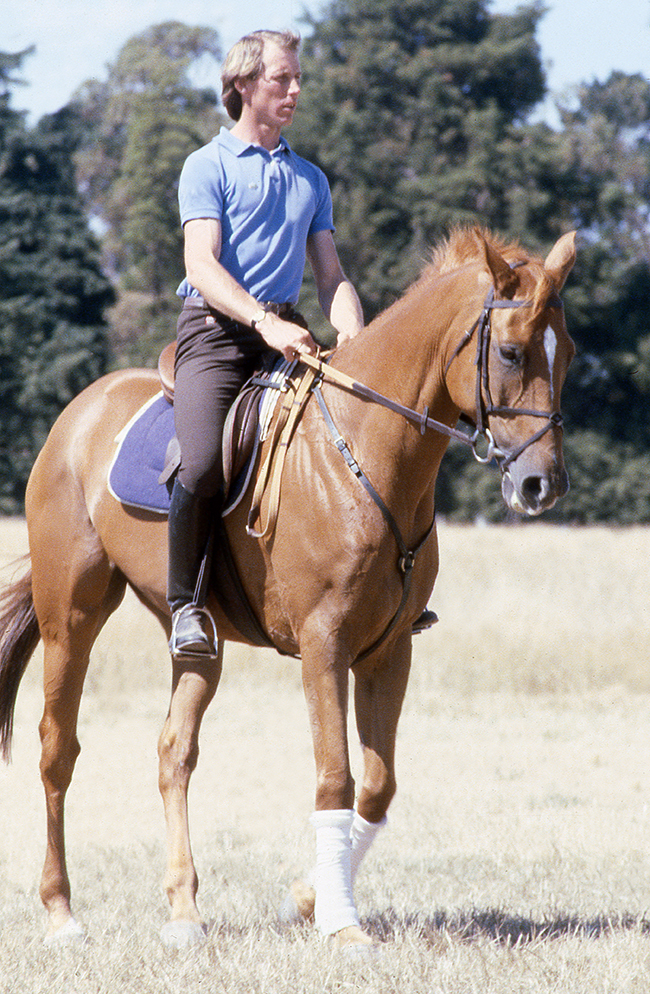
Today the horse will take exactly zero contact from the rider’s legs… that is when the session begins!
The lesson flows on from the back of the horse. ‘’You have to become intimately aware of the nature of the horse’s resistances. You have to be a little smarter than the horse is – you have to predict when he is going to resist. The horse will ask you to take the easiest option -which is not the correct one!”
“Because of this horse’s attitude to the leg I have to adopt a strategy of riding which I don’t like – a strategy of hand riding. The best I can hope for is relaxation on his terms – the worst, a lot of trouble! No. I will keep my legs there – like a tick on a dog, I will use passive resistance. Every time he relaxes he is going to get more calf until at the walk I can use all the leg I want.”
“There is not one horse in the world that can’t learn to accept your calves… there are hundreds that don’t. The first thing that the horse must learn is to accept the aids. Once he accepts the calf then he must move away from the calf to yield.”
Tad is starting to do some leg yielding exercises…
“In the working walk, I prompt a little lateral resistance to prompt a little yielding. He wants to reef at the reins – my passive resistance is never to let the contact loose. The idea is never to let him win with his resistance but to never actively fight him.”
It must be reported that the horse did not magically loose all tensions, that it did not immediately become well behaved and responsive – life is never like that. It did however become a good deal more rideable – it did at least get to the stage where the rider could begin to influence and correct the horse. And that, given the attitude of the horse at the beginning of the session, was no small feat!
Tad like any great teacher is as much a psychologist as a horseman. Reading his students, summing up the ones that need to be challenged, the ones that need to be kidded – finding exactly the right set of cues to snap the rider through a problem area, and always with the same zany sense of humour. The same withering critique for any lack of real effort. The same capacity to inspire greater efforts, more dedication, and more effective results…
“The great master, Gunner Andersen says – ‘If you want to make your horse beautiful, make him work a little’. The optimum is to be in perfect balance with the horse and be in a position to help him. That’s perfection. Come on let’s work on it… “
And as long as Tad keeps coming to Australia, there will be a legion of riders who will accept his invitation to work on achieving perfection.
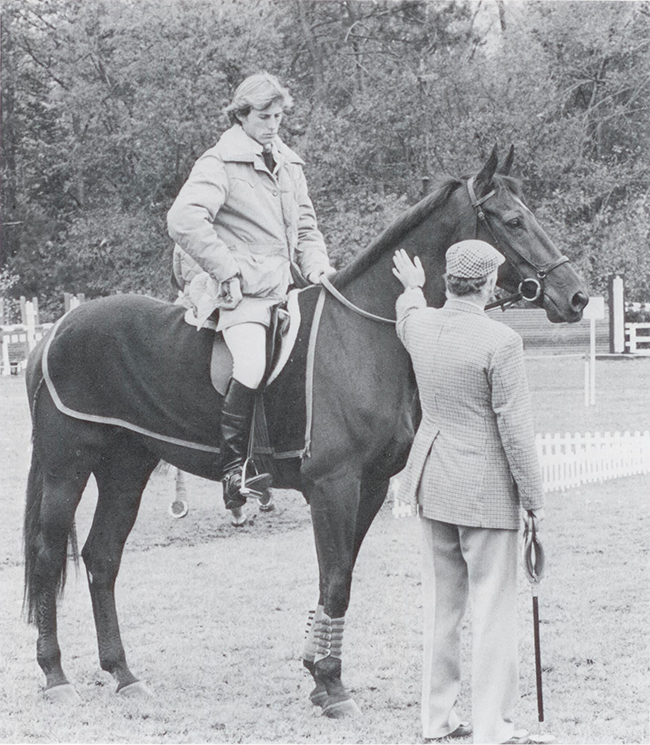 An Education in the Classical Principles
An Education in the Classical Principles
Tad Coffin was lucky not only to be given the opportunity to ride the great mare Ballycor to Olympic success – but lucky in that he was exposed to some of the greatest instructors in the modern equestrian world. It was an experience that was to provide Tad with an alternative challenge beyond the competition arena.
“At that point I became an instructor in the same way that I approached riding. With the idea in mind to be the best possible instructor that I can be. I think that teaching riders requires a tremendous amount of knowledge, a tremendous amount of experience, a tremendous amount of thought. It is an extremely challenging and difficult proposition. I think it is wonderful, I enjoy it immensely, and I am always striving to get better and better and better.”
“I think I am very lucky when I view most riders and trainers in the world. I think I am in the very small percentage that has really gotten a very good education. I worked with the co-director of the Westmoreland Davis Institute, Raul de Leon, for eight years as a junior. I was fortunate to be able to take three or four lessons a week from the time I was ten until the time I was eighteen, and Mr de Leon is a fabulous instructor.”
“Then I was fortunate enough to go right from there to work with Jack Le Goff for another six years. Jack left his mark in the United States in a way that no-one else in the world can or will. I think that there are a lot of people who don’t recognize what he did. I personally feel a great loyalty towards Jack Le Goff. I think that I recognize his contribution maybe a little more fully than some of the other riders.”
“So I have had fourteen years of probably the best riding education that one could ask for. And I have had the privilege of watching the very best riders and trainers in the world – and I have had the privilege of riding with them. I think riding requires a tremendous education.”
Certainly Tad is doing his best to provide access to the world’s most complete equestrian education. For a year and a half now, Tad, and his co-director, Raul de Leon have been operating a unique educational institution – The Westmoreland Davis Equestrian Institute.
“The institute was originally set up to answer the gap left by the closing of the cavalry schools. An institution where one could go and ride combined training horses, showjumpers and dressage horse – a place where one could live and breathe horses… and have top quality instruction.”
“The advantage of the school to my mind is that there are two of us teaching and two of us from very similar backgrounds. We do all of the teaching, there are no assistants who take part in the educational process. Not only can you experience riding on a personal level, with you one out with your horse, you can experience riding through the experiences of the other thirty five to forty students who are there. It is very different from putting your horse into a trailer, going for a lesson and then going home!”
“Because the students are with us on a full-time basis we can design the day as we like. We have theory lessons, we have lectures, we have demonstrations. In addition we have some very high quality school horses. So if someone wants to learn a little more about high level dressage, they can sit on one of the two Grand Prix dressage horses that we have, and learn what piaffe and passage feel like. There are horses that are well schooled over fences to give the rider the feel of the correct rhythm and approach.”
“Aside from working with Raul and myself, the students in the last year rode with Bert de Nementhy twice, Jack Le Goff once, Gunner Ostergaard three times, Sally Swift twice, and Hans Winkler once. There are no places in the world where that range of personalities are available in a lifetime – let alone a year.”
This article first appeared in the July 1986 issue of The Horse Magazine.
